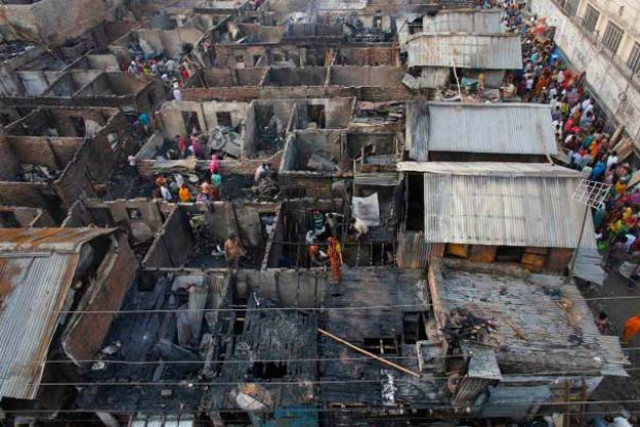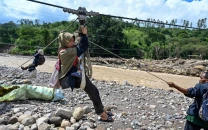Push to ward off disasters in Dhaka slum deters early marriage
Girls are married too young and many women fear for their safety in the slum's narrow alleyways after dark

PHOTO: REUTERS/FILE
There's a lack of water, as ever-longer dry spells and overuse of the city's groundwater empty wells. There's flooding when heavy rains do come, washing sewage from the community's open toilet and effluent from the nearby factory into homes and forcing families to wade to their wooden beds, propped up on bricks out of the floodwaters.
Electricity is scarce and costly. Jobs are hard to come by and poorly paid. Credit is available largely at loan-shark rates. Girls are married too young and many women fear for their safety in the slum's narrow alleyways after dark, residents say.
"And the heat!" lamented Abdul Sattar, an old man in a white prayer cap, his long beard tinged orange with henna. "The summer is longer and the heat is bad. Winter is disappearing. There's a big shift."
SC rejects plea against stay order, asks for report on ‘new’ slums
Climate change is making an already tough life even harder for many of the estimated 20 million people now crammed into heaving greater Dhaka. Its population continues to grow at nearly 5 per cent a year as migrants - many of whom have lost their farms to worsening erosion, storms and sea-level rise - flood in seeking new work.
"If we told them to go back, where would they go?" asked Sirajul Islam, chief urban planner for the Dhaka South City Corporation, which manages the southern half of Dhaka.
But at least some of the city's 3 million slum dwellers - many squeezed into one-room shacks of tin, bamboo, plastic sacks and wood - are now looking for ways to lower the risks from climate change and a host of other problems.
Solar panels to pumps
In Medical Slum, in Tongi district, a newly formed community development committee has over the last year mapped out threats to the neighbourhood, from flooding to pollution from the pharmaceutical plant, as well as resources, including a nearby police station and hospital.
With the map in hand, the community - most of them migrants who lost land in different parts of the country - has drawn up a list of its priorities for action.
Those include buying submersible pumps to clear away floodwater and obtain clean drinking water from a well, installing solar panels to power street lights, and eventually creating a few roads wide enough for fire trucks and other emergency vehicles to pass.
'Rana Plazas everywhere': Danger still haunts Bangladesh
The community's top priority - garbage collection, to help keep clear the drains that carry away floodwaters - has already been arranged for the first time through the municipal authority.
Some young members of the new committee have also been trained as emergency volunteers, to assist firefighters and police in the event of disasters.
"The community was not united earlier. We didn't interact with each other much. Now we do," said Poly, a 32-year-old development committee member who goes by one name, like many people in Bangladesh.
"We are a team and we are ready to act if something happens," she said.
Women's rights
The new social cohesion, and a big role for women in planning, are key to helping communities like Medical Slum begin to tackle some of their problems, said Palash Mondal of aid agency CARE.
It, with the Village Education Resource Centre (VERC), a local partner, is working with the community development committee to build resilience to threats in Medical Slum, backed by funding from the Switzerland-based C&A Foundation.
"Women are now aware of their rights and can raise their voices. Before we couldn't do this," said committee president Kalpona Begum, 55.
The community's meeting hall, a tin-roofed shed with a cardboard ceiling and orange tarp stretched over its concrete floor, is plastered with hand-drawn posters illustrating ways to reduce earthquake and fire risks and to combat social ills - including one image of an old man and a young girl in a red wedding veil, with a big red X marked over it.
Bangladesh workers demand justice after Rana Plaza disaster
The efforts to unite the community to build resilience to climate change and disasters have already helped halt at least one child marriage, said Shaheen, a VERC community coordinator.
Two months ago, she stopped by the home of a local widow, to find out if her 14-year-old daughter Jasmine, who had been forced to leave school as money was short, was interested in some training to become a garment factory worker.
Many slum residents find work at Dhaka's garment factories, earning about $50 per month of 12-hour shifts, or spend their days recycling plastic wrapping in sheds within the slum.
Jasmine's mother said the training wasn't necessary, as she planned to send her daughter back to their native village to marry.
Shaheen contacted members of a women's group, who visited to urge Jasmine's mother not to break the law by marrying her daughter at such a young age.
The woman relented and Jasmine, a shy, quiet girl in a red tunic, now stays at home in Medical Slum, watching her younger brothers during the day and spending time in the late afternoon with her 13-year-old friend Farjana, standing in the shade of the coconut trees just outside the slum's entrance.
She is relieved not to be on her way to becoming a bride just yet.
"Early marriage is not healthy for us," she said. "I am not yet mature enough to give birth."


















COMMENTS
Comments are moderated and generally will be posted if they are on-topic and not abusive.
For more information, please see our Comments FAQ